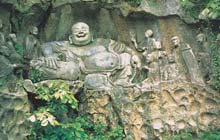
 Lingyin Temple, or the Temple of Inspired Seclusion, was founded in 326 AD by the Indian monk, Hui Li. It quickly became a center of worship for the Chan (Zen) Buddist sect, and once served as home to more than three thousand monks. During its turbulent history the temple has been destroyed and then restored no less than sixteen times with the current structures dating to the late Qing dynasty (1644-1911).
Lingyin Temple, or the Temple of Inspired Seclusion, was founded in 326 AD by the Indian monk, Hui Li. It quickly became a center of worship for the Chan (Zen) Buddist sect, and once served as home to more than three thousand monks. During its turbulent history the temple has been destroyed and then restored no less than sixteen times with the current structures dating to the late Qing dynasty (1644-1911).
Before reaching the temple however, you will pass a series of rock carvings on the "Peak that Flew from Afar". This was named in honor of the Indian monk, Hui Li, who commented that the mountain looked exactly like one in India. Between the tenth and fourteenth centuries, this peak's rock surfaces were carved with over three hundred Buddhist statues. One of the most famous is that of the Laughing Buddha, known as the Maitreya or the Buddha of the Future. Dedicated to him is a couplet which reads,
"His belly is big enough to contain all intolerable things in the world;
His mouth is ever ready to laugh at all snobbish persons under heaven."
It is believed that if you rub the belly of this Buddha, he will be able to foretell your future and make your wishes come true.
Lingyin temple, like many Chinese temples, is constructed according to a basic pattern. Built on a north-south axis with the main entrance to the south, it is surrounded by a protective perimeter wall. The main entrance, secured by heavy gates, is guarded by sculptures of the Four Guardian Warriors-protectors of the temple.
Standing behind these is a short spirit wall – this prevents direct entry to evil spirits, which are said to travel in straight lines. Circumambulating it, you will find yourself in a courtyard on the far side of which stand several enormous bronze vessels. These continue to be used to burn either incense or paper offerings to the gods.
Behind them is the first temple pavilion, usually elevated from the courtyard by a short set of steps. In front of the main Buddha stands an altar piece hosting such objects as candle holders, incense burners and an offering plate containing fruit, money and even candy. At Lingyin Temple, the central statue is an eighteen foot high statue of Sakyamuni, or the Historical Buddha, made in the Tang dynasty (607-960). Carved out of twenty-four pieces of camphor wood, it is said to be one of the largest wooden Buddhas in the world.
Typically this representation of the Buddha includes a glass ball on his forehead representing the eye of wisdom, long earlobes which portend longevity, the thumb-middle finger gesture signifying strength and wisdom, a lotus pedestal associated with purity (since the flower emerges unstained from the mud), and the nimbus behind his head which signals brightness. On this nimbus are carved the "seven ancient Buddhas" who symbolize the seven gems (gold, silver, glaze, glass, coral, agate and the conch shell) as well as the seven human emotions (joy, anger, melancholy, fear, love, hate and desire).
To proceed to the next courtyard you should walk to the back of the pavilion where an exit door, guarded by another deity, awaits you. Depending on the size of the temple complex, the number of successive courtyards will vary, with the most important buildings set deep into the complex so as to ensure ample protection from evil spirits.